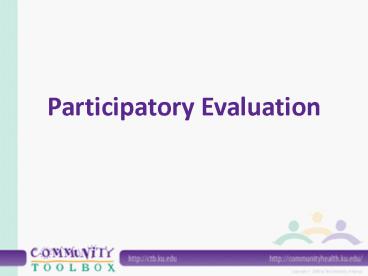Participatory Evaluation - PowerPoint PPT Presentation
1 / 12
Title:
Participatory Evaluation
Description:
People's lives illness, child care and relationship problems, ... Use your analysis to celebrate what worked and adjust the rest to improve the project. ... – PowerPoint PPT presentation
Number of Views:50
Avg rating:3.0/5.0
Title: Participatory Evaluation
1
Participatory Evaluation
2
What is participatory evaluation?
- Participatory evaluation is an evaluation that
involves all the stakeholders in a projectthose
directly affected by it or carrying it outin
every phase of evaluating it, and in applying the
results of that evaluation to the improvement of
the work.
3
Why would (and wouldnt) you use participatory
evaluation?
4
Advantages
- If gives you a better perspective on both the
initial needs of the projects beneficiaries, and
on its ultimate effects. - It can get you information you wouldnt get
otherwise. - It tells you what worked and what didnt from the
perspective of those most directly
involvedbeneficiaries and staff. - It can tell you why something does or doesnt
work.
5
Advantages (cont.)
- It results in a more effective project.
- It empowers stakeholders.
- It can provide a voice for those who are not
often heard. - It teaches skills that can be used in employment
and other areas of life. - It bolsters self-confidence and self-esteem in
those who may have little of either.
6
Advantages (cont.)
- It demonstrates to people ways in which they can
take more control of their lives. - It encourages stakeholder ownership of the
project. - It can spark creativity in everyone involved.
- It encourages working collaboratively
- It fits into a larger participatory effort.
7
Disadvantages
- It takes more time than conventional process
- It takes the establishment of trust among all
participants in the process. - You have to make sure everyones involved, not
just leaders of various groups. - You have to train people to understand evaluation
and how the participatory process works, as well
as teaching them basic research skills.
8
Disadvantages (cont.)
- You have to get buy-in and commitment from
participants. - Peoples livesillness, child care and
relationship problems, bringing the crops in,
etc.may cause delays or get in the way of the
evaluation. - You may have to be creative about how you get,
record, and report information. - Funders and policy makers may not understand or
believe in participatory evaluation.
9
When would you use participatory evaluation?
- When youre already committed to a participatory
process for your project. - When you have time, or when results are more
important than time. - When you can convince funders that its a good
idea. - When there may be issues in the community or
population that outside evaluators or program
providers arent likely to be aware of.
10
Who should be involved?
- All stakeholders including
- Participants or beneficiaries
- Project line staff and or volunteers
- Administrators
- Outside evaluators, if theyre involved
- Community officials
- Others whose lives are affected by the project
11
How do you conduct a participatory evaluation?
- Recruit stakeholders as participatory evaluators
- Train evaluators
- Name and frame the issue
- Develop a theory of practice and address it
12
How do you conduct a participatory evaluation?
(cont.)
- Determine the evaluation questions
- Collect information
- Use your analysis to celebrate what worked and
adjust the rest to improve the project. - Stick with it indefinitely































